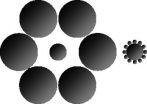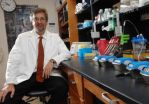(Press-News.org) Wellcome Trust scientists have shown for the first time that exactly how we see our environment depends on the size of the visual part of our brain.
We are all familiar with the idea that our thoughts and emotions differ from one person to another, but most people assume that how we perceive the visual world is usually very similar from person to person. However, the primary visual cortex – the area at the back of the brain responsible for processing what we see in the world around us – is known to differ in size by up to three times from one individual to the next.
Now, researchers at the Wellcome Trust Centre for Neuroimaging at UCL (University College London) have shown for the first time that the size of this area affects how we perceive our environment. Their study is published online today in the journal Nature Neuroscience.
Dr D Samuel Schwarzkopf, Chen Song and Professor Geraint Rees showed a series of optical illusions to thirty healthy volunteers. These included the Ebbinghaus illusion, a well-known illusion in which two circles of the same size are each surrounded by circular 'petals'; one of the circles is surrounded by larger petals, the other by smaller petals. Most people will see the first circle as smaller than the second one
In a second optical illusion, the Ponzo illusion, the volunteers were shown two identically sized circles superimposed onto the image of a tunnel. In this illusion, the circle placed further back in the tunnel appears larger than that placed near the front.
By adapting these illusions, the researchers were able to show that individual volunteers saw the illusions differently. For example, some people saw a big (although illusory) difference in size between the two circles, but others barely saw any difference in apparent size.
Using functional magnetic resonance imaging (fMRI), the researchers were also able to measure the surface area of the primary visual cortex in each volunteer. They found a great deal of variability in the size of this area. Surprisingly, there was a strong link between its size and the extent to which volunteers perceived the size illusion – the smaller the area, the more pronounced the visual illusion.
"Our work is the first to show that the size of part of a person's brain can predict how they perceive their visual environment," explains Dr Schwarzkopf.
"Optical illusions mystify and inspire our imagination, but in truth they show us that how we see the world is not necessarily physically accurate, but rather depends a lot on our brains. Illusions such as the ones we used influence how big something looks; that is, they can trick us into believing that two identical objects have different sizes.
"We have shown that precisely how big something appears to you depends on the size of a brain area that is necessary for vision. How much your brain tricks you depends on how much 'real estate' your brain has put aside for visual processing."
INFORMATION:
Seeing the world differently
How the brain's architecture makes our view of the world unique
2010-12-06
ELSE PRESS RELEASES FROM THIS DATE:
Northern wildfires threaten runaway climate change, study reveals
2010-12-06
Climate change is causing wildfires to burn more fiercely, pumping more greenhouse gases into the atmosphere than previously thought, according to a new study to be published in Nature Geosciences this week.
This is the first study to reveal that fires in the Alaskan interior - an area spanning 18.5 million hectares - have become more severe in the past 10 years, and have released much more carbon into the atmosphere than was stored by the region's forests over the same period.
"When most people think of wildfires, they think about trees burning, but most of what fuels ...
New research shows rivers cut deep notches in the Alps' broad glacial valleys
2010-12-06
For years, geologists have argued about the processes that formed steep inner gorges in the broad glacial valleys of the Swiss Alps.
The U-shaped valleys were created by slow-moving glaciers that behaved something like road graders, eroding the bedrock over hundreds or thousands of years. When the glaciers receded, rivers carved V-shaped notches, or inner gorges, into the floors of the glacial valleys. But scientists disagreed about whether those notches were erased by subsequent glaciers and then formed all over again as the second round of glaciers receded.
New ...
Study reveals new possibility of reversing damage caused by MS
2010-12-06
Damage caused by multiple sclerosis could be reversed by activating stem cells that can repair injury in the central nervous system, a study has shown.
Researchers from the Universities of Cambridge and Edinburgh have identified a mechanism essential for regenerating insulating layers – known as myelin sheaths – that protect nerve fibres in the brain. In additional studies in rodents, they showed how this mechanism can be exploited to make the brain's own stem cells better able to regenerate new myelin.
In multiple sclerosis, loss of myelin leads to the nerve fibres ...
'Shotgun' method allows scientists to dissect cells' sugar coatings
2010-12-06
Sugar molecules coat every cell in our bodies and play critical roles in development and disease, yet the components of these "glycans" have been difficult for scientists to study, because of their complexity.
Researchers at Emory University School of Medicine have adapted gene chip microarray technology to the study of glycans, with an approach they call "shotgun glycomics." The Emory team has developed a new chemical method for attaching a fluorescent dye to glycans purified from cells. The individual glycans are separated into tiny spots fixed to glass slides.
The ...
Over-reactive immune system kills young adults during pandemic flu
2010-12-06
On November 19, Jason Martin returned to the Medical Intensive Care Unit (MICU) at Vanderbilt University Medical Center for the first time since he nearly died there during last year's H1N1 flu pandemic. The tall and burly Warren County, TN, ambulance worker – a 30-year-old, father of three young children – broke down and hugged some of the nurses he recognized.
"I got sick on September 12 and didn't come out of it for the next 20 days. I am just so grateful I came through," Martin said, wiping his eyes.
Martin was among the first wave of critically ill middle Tennesseans, ...
The LouseBuster returns
2010-12-06
SALT LAKE CITY, Dec. 6, 2010 – Four years after the LouseBuster prototype made headlines when research showed the chemical-free, warm-air device wiped out head lice on children, a new study reveals that a revamped, government-cleared model is highly effective.
"For a louse, it's like sticking your head out a window at 100 miles an hour; they're going to get dried out," says University of Utah biology Professor Dale Clayton, senior author of the study and a founder of Larada Sciences, a university spinoff company that sells or leases the LouseBuster to schools, ...
Study finds family acceptance of LGBT youth protects against depression, substance abuse, suicide
2010-12-06
For the first time, researchers have established a clear link between accepting family attitudes and behaviors towards their lesbian, gay, bisexual and transgender (LGBT) children and significantly decreased risk and better overall health in adulthood. The study shows that specific parental and caregiver behaviors -- such as advocating for their children when they are mistreated because of their LGBT identity or supporting their gender expression -- protect against
depression, substance abuse, suicidal thoughts and suicide attempts in early adulthood. In addition, LGBT ...
Researchers: Include data about societal values in endangered species decisions
2010-12-06
COLUMBUS, Ohio – The U.S. Fish and Wildlife Service is excluding significant research findings about human threats to protected species, researchers argue, even when the law governing the agency's actions requires the use of all relevant data in determining whether species need protection from extinction.
A group of scientists, led by Jeremy Bruskotter of Ohio State University, argue in the December issue of the journal BioScience that research about societal values should be considered along with biological and ecological data in listing decisions.
The Endangered Species ...
Forest pests accumulating despite regulations
2010-12-06
Nonindigenous insects and pathogens continue to become established in US forests with regularity despite regulations intended to prevent this, according to a study published in the December 2010 issue of BioScience. The study, by a team led by Juliann E. Aukema of the National Center for Ecological Analysis and Synthesis in Santa Barbara, California, found that nonindigenous insects are being newly detected in US forests at a rate of about 2.5 per year, and high-impact insects and pathogens that cause significant effects in forests, including tree death, are being newly ...
Lesbian, gay and bisexual teens singled out for punishment
2010-12-06
Lesbian, gay and bisexual (LGB) adolescents are about 40 percent more likely than other teens to be punished by school authorities, police and the courts, according to a study by Yale University researchers. Published in the January 2011 issue of the journal Pediatrics, the study is the first to document excessive punishment of LGB youth nationwide.
"We found that virtually all types of punishment—including school expulsions, arrests, juvenile convictions, adult convictions and especially police stops—were more frequently meted out to LGB youth," said lead author Kathryn ...
LAST 30 PRESS RELEASES:
How do health care professionals determine eligibility for MAiD?
Microplastics detected in rural woodland
JULAC and Taylor & Francis sign open access agreement to boost the impact of Hong Kong research
Protecting older male athletes’ heart health
KAIST proposes AI-driven strategy to solve long-standing mystery of gene function
Eye for trouble: Automated counting for chromosome issues under the microscope
The vast majority of US rivers lack any protections from human activities, new research finds
Ultrasound-responsive in situ antigen "nanocatchers" open a new paradigm for personalized tumor immunotherapy
Environmental “superbugs” in our rivers and soils: new one health review warns of growing antimicrobial resistance crisis
Triple threat in greenhouse farming: how heavy metals, microplastics, and antibiotic resistance genes unite to challenge sustainable food production
Earthworms turn manure into a powerful tool against antibiotic resistance
AI turns water into an early warning network for hidden biological pollutants
Hidden hotspots on “green” plastics: biodegradable and conventional plastics shape very different antibiotic resistance risks in river microbiomes
Engineered biochar enzyme system clears toxic phenolic acids and restores pepper seed germination in continuous cropping soils
Retail therapy fail? Online shopping linked to stress, says study
How well-meaning allies can increase stress for marginalized people
Commercially viable biomanufacturing: designer yeast turns sugar into lucrative chemical 3-HP
Control valve discovered in gut’s plumbing system
George Mason University leads phase 2 clinical trial for pill to help maintain weight loss after GLP-1s
Hop to it: research from Shedd Aquarium tracks conch movement to set new conservation guidance
Weight loss drugs and bariatric surgery improve the body’s fat ‘balance:’ study
The Age of Fishes began with mass death
TB harnesses part of immune defense system to cause infection
Important new source of oxidation in the atmosphere found
A tug-of-war explains a decades-old question about how bacteria swim
Strengthened immune defense against cancer
Engineering the development of the pancreas
The Journal of Nuclear Medicine ahead-of-print tip sheet: Jan. 9, 2026
Mount Sinai researchers help create largest immune cell atlas of bone marrow in multiple myeloma patients
Why it is so hard to get started on an unpleasant task: Scientists identify a “motivation brake”
[Press-News.org] Seeing the world differentlyHow the brain's architecture makes our view of the world unique




